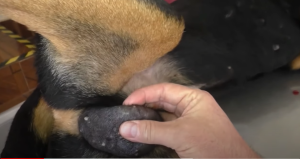
An outbreak of mangoworms, the creepy crawly maggots that burrow under human and animal skins, has been announced in Mwea area of Kirinyaga county.
The worms were generally thought to affect stray puppies in the Gambia and in Central Africa, and medics say this is the first time an outbreak is being reported in Kenya.
Kirinyaga County executive member for health Wambu Miano said at least 100 people with the affliction have attended different dispensaries in the county.
He said the situation is being treated as a medical emergency.
The outbreak started last year, with most of the cases being reported in December.
The county is now conducting campaigns in Mwea West and parts of Ndia, where the highest number of cases has been reported.
Miano said farmers should always spray animals (cows, dogs and cats) regularly and also spray outside the cowshed to kill the eggs that breed in the sheds.
He advised those living in mud houses to continue smearing them to seal cracks where the flies may lay eggs.
“We have to go back to what we used to do: smearing mud houses with cow dung, many did not know why it was done, it was to keep away flies from breeding in the cracks. So let’s go back to smearing to seal cracks that are breeding areas for flies,” said Wambu.

Residents are also being advised to observe personal hygiene and avoid mosquito or fly bites.
We found 70-year-old Kibara wa Kagata at Kang’aru Dispensary where she was having the mangoworms removed. Ten of them were extracted from two wounds on her leg.
Kibaara says it all started with an itch that turned red, followed by a swelling. The pain was unbearable for two weeks after which some worms started popping out.
“I have never felt such pain in my life. These worms have caused me sleepless nights, I have cried telling my son to have them removed. Sometimes I could not move since my leg had become numb,” said Kibaara.
Josephine Wangari, whose standard seven daughter had a mangoworm at the buttock said she scratched herself uncontrollably. The family bought her some antibiotics, thinking that she had an allergy. After two weeks, there was a protruding red pimple. When it was squeezed, a live worm came out. The mother assumed this was because the daughter had been wetting her bed.
Kirinyaga acting public health director Evans Kago said mangoworms are brought about by poor hygiene.
He adds that the warm, damp conditions brought by the El Nino rains are conducive for its reproduction.
The worm comes after the mango fly lays eggs on the ground or on clothes hung outside.
When those clothes are worn, then the eggs hatch and the larva burrows under the skin.
The body starts itching within three days. Within eight to 12 days the sores with pus erupt, and that is when the worm comes out. One can even actually feel the worms wriggling around in the body.
Children playing outside or even adults working in the field can also come into contact with these eggs, which penetrate the skin and lie in the subcutaneous tissue.
Dogs and rodents are usually the hosts, but humans often become accidental hosts, Kago said.

He added that mango worms do not pose a serious health risk. They do not carry other diseases with them and they do not cause complications themselves outside of the boil that they create. It is important, however, to remember to thoroughly disinfect the area after the worm has emerged from the body.
Kago said it is also important to iron all clothes with a hot iron as this will kill any eggs laid on them. The other possibility is not to wear them for 48 hours after they have dried, as this is longer than the lifespan of the eggs. As another preventative measure, clothes should not be left on the ground to dry. This applies to all garments including sheets, towels and bedding, he says.
“Clothes are supposed to be hung in an open area where they can get direct sunlight, avoid hanging them under trees, hanging lines that are normally under the roof, ” he said.
The medic also advises those who may have been infected by the larvae of a mango fly to see a doctor immediately. “Attempting to remove the larva yourself could cause severe pain, rupturing and further infection,” Kago said.
He says some patients who tried to express the larvae by themselves left the shell in the body, thus continuing the infection.
“When the mangoworms are removed, they are supposed to be killed to cut the continuation of reproducing and also to avoid them re-burrowing in other humans,” he said.
Kago said animal sheds should be situated away from houses, be kept clean and dry so as not to create breeding places for the flies.
He said the ongoing sensitisation focuses on the importance of keeping home compounds clean and personal hygiene.

Watch Full Video Now 👇



